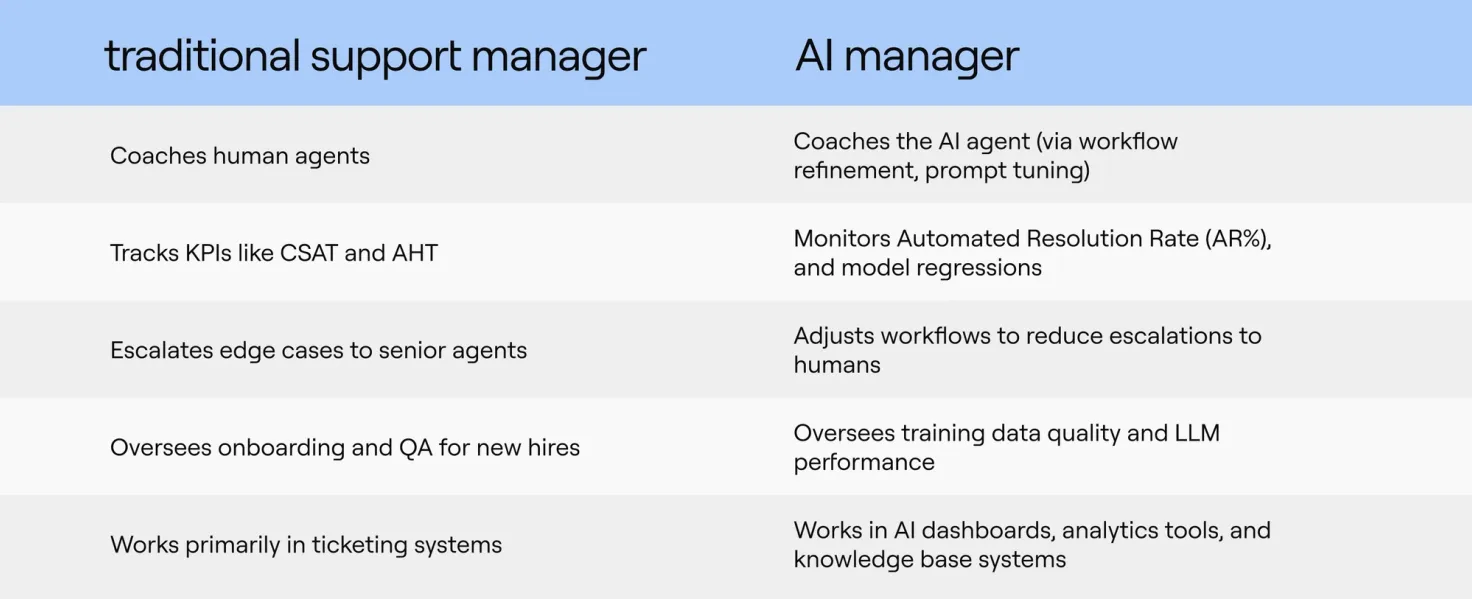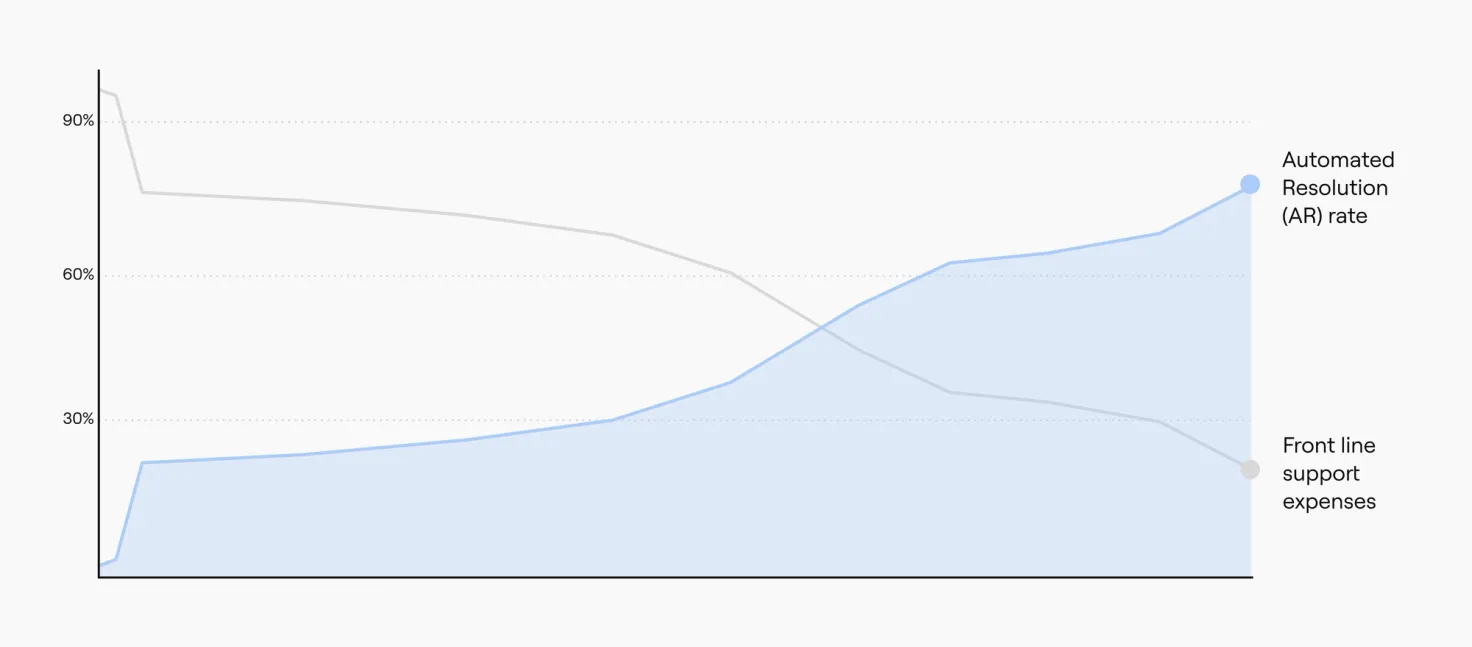
how to prioritize tech stack investments for AI customer service
Learn how to invest in systems that boost AI performance, CSAT, and ROI, without bloating your customer service tech stack.
Learn More

The most important customer service hire in 2025 isn’t a senior support manager. It isn’t a chatbot designer. It’s not even a data scientist.
It’s the AI Manager.
Five years ago, this role didn’t exist. AI was a tool—something support teams experimented with at the edges of their operations. Today, AI agents are frontline team members. They're resolving tickets, surfacing answers, and making judgment calls that used to belong to live agents.
We’ve seen this play out before. In the early days of CRM platforms, companies went all in on software but forgot to fund the role of CRM administrators. The result? Underused tools, messy data, and wasted spend.
The same fate awaits companies adopting AI without someone accountable for performance, training, and governance . As your organization automates more, the scale and stakes of AI management increase. That’s why you should assign this ownership early; dedicating ownership to a single person or team unlocks compounding returns from automation.
If you’re building a modern support organization , this is the cornerstone role you need now. The age of AI customer service is here—and the AI Manager ensures it runs like a well-oiled machine.
Here’s the hard truth: adding AI to your support stack without assigning someone to manage it is like buying a race car and never hiring a pit crew. Sure, it might start fast—but it won’t stay on the track for long.
As companies adopt AI agents to scale support , the assumption is often: “We’ll set it up and it’ll run itself.” But in practice, AI systems are only as effective as their ongoing supervision, training, and integration. And that responsibility can’t be shared vaguely across your support, product, and engineering teams. It needs a dedicated owner.
That’s the AI Manager.
Without a dedicated owner, AI systems stagnate, resolution quality declines and customers get frustrated. This leads to increased escalations, lower containment, inconsistent brand voice, and support costs creeping back up.
Teams without an AI Manager experience:
And it’s not just operational pain. It’s financial.
As AI moves from novelty to necessity in customer service, it’s no longer enough to plug in a model and let it run. Someone has to make sure the AI is doing its job well.
The AI Manager is the person responsible for coaching and optimizing AI agents to improve automated resolution (AR) over time. In other words: they don’t just keep the lights on—they make the AI better every day.
They’re the operational brain behind your AI customer experience, making sure the AI agent delivers meaningful, accurate, brand-aligned support at scale.
This isn’t just a technical role—it’s operational, strategic, and deeply customer-focused. The AI Manager ensures your AI agent is actually helping (not hurting) your customer experience.

While the AI Manager role is new, it intersects, and diverges, from traditional support management in key ways.
In a traditional setup, a Support Manager oversees hiring, agent training, and performance reviews. Their job is to coach people. The AI Manager is responsible for training and improving the performance of the AI agent to optimize resolution rates. This means they own the workflows, reporting, and quality checks that ensure the AI agent is doing their job effectively.
While a Support Manager keeps the human side of service humming, the AI manager ensures automation works as intended. They don’t replace each other; they complement each other.
Here’s how these two roles compare at a high level:

The simple answer: the tech wasn’t ready.
As recently as 2020, AI in customer service meant rigid decision trees and narrow NLP models. Today, with generative AI and LLM-powered agents, the scope has shifted dramatically.
Now, your AI agent is writing responses in real time, drawing from live data, integrating with APIs, and making decisions. That’s not something you can “set and forget.” It requires continuous training, monitoring, and improvement.
Watch Ada's spring product launch to experience the most human AI in action, see live demos of an AI agent learning & adapting, and learn how leading brands scale with empathy.
Watch on-demand
If “AI Manager” sounds vague, that’s because it’s still being defined in real time. But for teams scaling automation seriously, the role is already indispensable.
The AI Manager’s core goal is increasing AR—not just avoiding escalations, but actively delivering better answers, faster. That means they’re not judged on how quiet the AI is. They’re judged on how effective it is.
So when support leaders look at automation ROI, they shouldn’t be asking, “How many tickets did AI deflect?” They should be asking, “How many problems did our AI Agent actually solve?”
What does this look like exactly? Owning the performance of the AI agent from end-to-end, including the day-to-day optimization tasks like updating workflows, training content, and monitoring performance analytics. Let’s break that down into a sample day.
A typical day starts with evaluating the performance of the AI agent using AR, CSAT, and feedback signals:

This is where the AI Manager earns their keep. They:
They may also:
For organizations further along in their AI maturity, the AI Manager is also responsible for:
As automation scales, the AI Manager must take on technical ownership to ensure the AI agent interacts reliably with third-party systems.
No AI agent exists in a vacuum. The AI Manager works with:
They also prepare performance reports. These typically include:
In more mature teams, the AI Manager isn’t just an operator. They’re a strategist. They help answer big questions like:
That’s why many companies eventually level up this role into something broader—like an ACX Director or Head of AI Support Strategy.
Don’t wait for your competition to catch up. Take the first step toward mastering AI customer service. Here are the 5 essential dimensions of a thriving ACX program.
Get the guide
It’s tempting to think of the AI Manager role as “nice to have”—something for later, once you’ve scaled up your automation or proven ROI. But the data (and the trajectory of every forward-thinking support org) says otherwise.
Companies that assign clear AI ownership early see faster returns, better customer outcomes, and compounding automation gains. Why? Because AI doesn’t manage itself. It needs structured oversight to improve—just like a team member would.
But these gains aren’t magic. They’re managed. The impact of a well-run AI Agent goes far beyond ticket deflection:

Investing in human oversight of AI accelerates ROI—not because the AI can’t function without it, but because the system improves faster with structured ownership. That’s what the AI Manager delivers: structured ownership, continuous optimization, and accountability for automation that actually works.
They’re not a stopgap title. They’re not a fringe hire. The AI Manager is the keystone role in every customer service team serious about AI.
So if you're investing in AI, ask yourself the hard question: Who’s making sure it’s working? Who’s making it better?
If you don’t have an answer yet, you need an AI Manager.
Don’t let an outdated team structure hold you back. Start building a customer service team that uses both AI and human agents to their fullest potential.
Get the guide